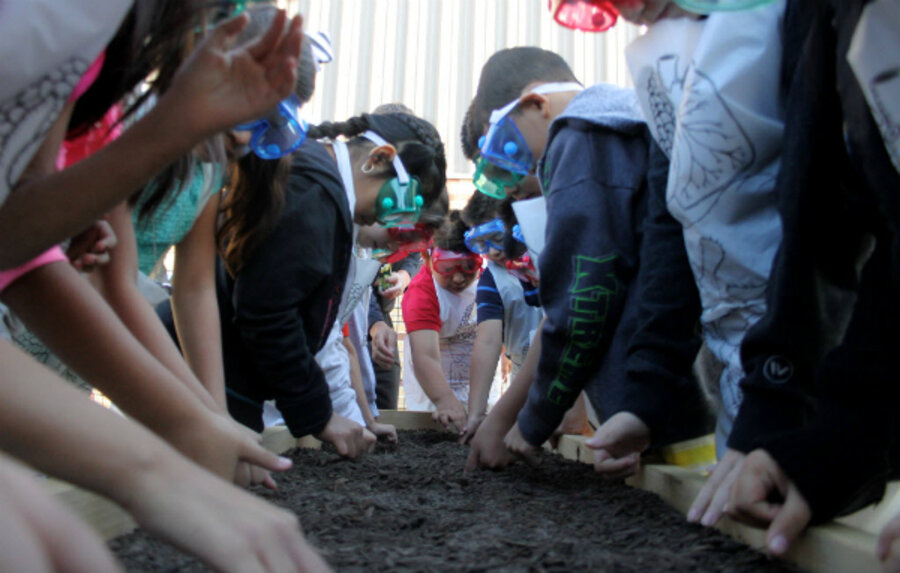Learning gardens teach kids to love the outdoors
Loading...
Kitchen Community, the nonprofit wing of Kimbal Musk’s “The Kitchen” restaurants, has installed more than 150 Learning Gardens in six different states over the last two years. Scalable 500-3,000 square foot outdoor classroom installments, Learning Gardens are built by students and project sponsors. The purpose: “to encourage spontaneous play in the garden, to create an attractive outdoor classroom for teachers, and to be a positive long term investment for schools everywhere”.
I recently had the opportunity to speak with Kimbal Musk about these Learning Gardens.
SG: How did the idea of a learning garden evolve?
KM: Up until three years ago, learning gardens were great at reaching kids in a place like Boulder, CO. The question, for me, was one of scale. By scale I mean, how do we get learning gardens to places like Chicago, New York and Los Angeles? Traditionally, school gardens were in a corner of a schoolyard—I noticed they were designed to keep the students out. Teachers were worried that the students would damage the garden if they were allowed in. The only time a student was allowed to enter the garden was when someone was holding their hand. Students, in this way, get very little exposure to the garden. We wanted the gardens right in the middle of the playground—so we created a product called The Learning Garden: a playground in an outdoor, edible classroom. What we found was that there was no risk of students damaging the playground. We also found that if you put a fence up, the garden will fail. We were turning people away if they said they wanted to build a fence.
SG: Why would they fail?
KM: If there were a fence, the garden would be out of sight and out of mind. Students needed to be interacting in the garden: sometimes playing, learning a lesson or reading a book. Another logistics thing: if there were a fence, facilities departments would not cross it; they would stop at it.
SG: Would you ever put learning gardens on a roof?
KM: We have, though to us, that’s the same as putting a fence around it. We want the students in the garden every day.
SG: In December 2013, Kitchen Community and Chicago Public Schools built and opened the hundredth Learning Garden in Chicago at the Peirce Elementary School. What are the next steps in facilitating greater connection between public schools and the food consumed in them?
KM: What’s critical is to turn the learning garden into part of the instruction process in schools. We’re working with CPS to push for 5% of all classes with learning gardens to be taught in the garden. When you teach kids in the learning garden, you start treating it like a classroom. There’s really no better way to get kids connected to foods. You teach how the embryo grows in the garden. You teach the volume of water. Test scores go up when kids are learning in the garden.
SG: So I’m looking outside right now and it’s about five degrees out and there’s snow everywhere in Chicago—what’s happening now at Chicago learning gardens?
KM: Not much planting. You’ll be seeing mulch on the gardens now. In the fall, before the snow, students plant garlic and tulips. Little trick of the spring is that you’ll know when spring is coming when the tulips start to come up. When you see the tulips, it’s time to start planting the peas and carrots. Flowers start to grow around May 10th .
SG: Why do you think students—and adults—enjoy the growing process so much?
KM: I think it’s biological. It’s just one of those things. Gardens are used as therapy in prisons. When you grow something you understand the life cycle of it. If you don’t take care of it, it will die. Even the annual life cycle of the garden itself. In November, we call it “putting the garden to bed”. We plant seeds that will come up in the spring. It’s quite a cathartic process.
The Kitchen and Learning Gardens give young people the opportunity to become participants in the natural growing cycle of a given product. By being involved in the process, from research, to harvest, to cultivation, to consumption, students generate a greater awareness of the resources needed to deliver food to plate. Visit Learning Gardens official site to see if a garden may be coming to a space near you. Or, to be a stakeholder in your own community’s garden, learn the necessary course of action here.





